 W
WThe Type 143 Albatros class was a German class of missile bearing fast attack craft. Each vessel is named after a bird of prey including the albatross, condor and cormorant. Constructed by German shipbuilders Lürssen and Kröger, the vessels were intended to replace the Type 141 Seeadler class. The German Navy retired the class in 2005 and sold the boats off to Tunisia and Ghana.
 W
WThe Ambassador MK III fast missile craft or Ezzat class is a small warship built by VT Halter Marine for the Egyptian Navy. Four ships were planned at a total cost of US$1.290b; the first, S. Ezzat, was handed over in November 2013 and the remainder were scheduled to follow in 2013-14. Egypt already operated Halter's Ambassador design as a patrol boat for their Coast Guard fleet, and chose a variant of the design with reduced radar cross-section as the basis for a large modern missile boat. Its design was conducted with the assistance of Lockheed Martin.
 W
WThe Azmat-class fast attack craft is a class of missile-bearing fast attack craft, currently in service with the Pakistan Navy as of 2017. The Azmat class is based on the Chinese design, Houjian class, with slightly different modifications for the need of the Pakistani military.
 W
WThe Azmat-class fast attack craft is a class of missile-bearing fast attack craft, currently in service with the Pakistan Navy as of 2017. The Azmat class is based on the Chinese design, Houjian class, with slightly different modifications for the need of the Pakistani military.
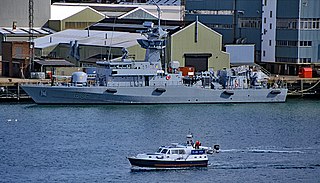 W
WThe Barzan class is a class of 4 British-designed fast attack missile boats for the Qatari Emiri Navy, also known as Super Vita.
 W
WThe C 14 class missile boat is a light missile boat of catamaran designed for use in the Middle East, also known as the China Cat class. The small size of the ship, along with some stealth features provide it with good protection against enemy detection, and it can be armed with a variety of light anti-ship missiles. In addition to the low radar cross section, the boat is also extremely fast with an aluminum monohull with stepped planning.
 W
WThe Clurit class fast attack craft are a class of domestically designed and built warships operated by the Indonesian Navy. Vessels of this class are named after indigenous weapons and swords used in Indonesia.
 W
WThe Doğan Class is one of the Fast Attack Craft / Missile Boat classes of the Turkish Navy.
 W
WA fast attack craft (FAC) is a small, fast, agile and offensive warship armed with anti-ship missiles, gun or torpedoes. FACs are usually operated in close proximity to land as they lack both the seakeeping and all-round defensive capabilities to survive in blue water. The size of the vessel also limits the fuel, stores and water supplies. In size they are usually between 50–800 tonnes and can reach speeds of 25–50 knots.
 W
WThe Type 143A Gepard class was a class of missile bearing fast attack craft and the last one in service with the German Navy before the remaining four operational ships were decommissioned on 16 November 2016. The Ghana Navy operates two such ships.
 W
WThe Hamina-class missile boat is a class of fast attack craft of the Finnish Navy. They are classified as "missile fast attack craft" or ohjusvene, literally "missile boat" in Finnish. The Hamina FACs are based at Upinniemi, and form the 7th Surface Warfare Squadron, part of the Finnish Coastal Fleet, together with the minelayers MLC Hämeenmaa, Porkkala and Pyhäranta.
 W
WThe Handalan-class are domestically modified Spica-M fast attack craft, a heavier variant of the Swedish Spica II (Norrkoping) class. Built by Kalskrona Varvet and ordered in 1976, this class replaced the Perkasa-class squadron on a 1:1 basis, including name transfer.
 W
WThe Hayabusa-class is a guided missile patrol boat class of the Japan Maritime Self-Defense Force. Six boats were built between 2002 and 2004.
 W
WHelsinki-class missile boat is a class of four fast attack craft built for the Finnish Navy. All the ships were constructed at the Wärtsilä Helsinki Shipyard, Finland, and had Pansio as their homeport.
 W
WThe Intrépida class is a class of fast attack craft that was built by Lürssen for the Argentine Navy in the early 1970s. The ships are based on Lürssen's TNC 45 design.
 W
WThe Kılıç class is one of the fast attack craft / missile boat classes of the Turkish Navy. It is defined as a corvette by Lürssen Werft, the German designer of the vessel.
 W
WKlewang- class fast attack craft is the futuristic design and stealth wave-piercing trimaran carbon fast attack craft that made by PT Lundin Industry Invest. On September 28, 2012, Klewang was destroyed by fire being outfitted at shipyard.
 W
WThe Soviet Project 183R class, more commonly known as the Komar class, its NATO reporting name, meaning "mosquito", is a class of missile boats, the first of its kind, built in the 1950s and 1960s. Notably, they were the first to sink another ship with anti-ship missiles in 1967.
 W
WThe Končar class is a class of six missile boats built for the Yugoslav Navy during the late 1970s at Tito's Shipyard Kraljevica, SR Croatia. The boats featured a mixture of Western and Eastern European equipment, including Soviet anti-ship missiles and Swedish guns.
 W
WThe Kralj class is a class of two missile boats, one of which was on order for the SFR Yugoslav Navy and one of which, following the break-up of Yugoslavia, was built for the Croatian Navy. As of 2009 both vessels remain in service. It is an upgraded version of the Rade Končar missile boat class and is 8.5 metres (28 ft) longer. Kralj Petar Krešimir IV and its sister ship Kralj Dmitar Zvonimir are the only ships in their class. A potential third ship was under consideration in 1999, but the ship was never commissioned due to budget restraints.
 W
WThe Kuang Hua VI class missile boat is a type of patrol craft in service with the Republic of China Navy (ROCN). The prototype was launched in 2003, and the boat first entered service by 2010.
 W
WThe La Combattante IIa fast attack craft is a class of fast attack craft originally built for the German Navy as Type 148 Tiger-class fast attack craft. They were later transferred to the Hellenic Navy and the class was renamed Combattante IIa, as with similar French made ships. All the ships were under mid-life updates in 1980s. Two vessels in the class, P-74 and P-75, were fitted with RGM-84 Harpoon anti-ship missiles and a new ESM was fitted after transfer.
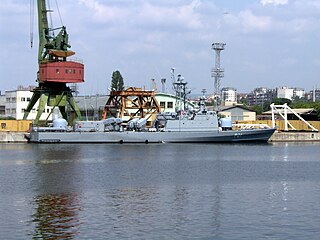 W
WThe La Combattante III type missile boats of the Hellenic Navy are a class of four fast attack craft ordered by Greece in September 1974 from France. The vessels had no class name but are referred to by type. They are similar to the La Combattante IIa-class fast attack craft already in service, but are larger and armed with torpedoes. A second group of six were ordered in 1978, to be built under license in Greece and use Penguin Mk 2 Mod 3 missiles. Since 2019, all the ships of the class use Harpoon anti-ship missiles.
 W
WThe Mandau-class, Indonesian designation KCR-PSK, is a class of four missile-armed fast attack craft that currently operated by the Indonesian Navy. They were built by the Korea Tacoma Marine Industries from South Korea between 1977 to 1980.
 W
WThe Matka class is the NATO reporting name for a group of hydrofoil missile boats built for the Soviet Navy. The Soviet designation is Project 206MR Vikhr. Following the 1997 Black Sea Fleet partition treaty all Black Sea Fleet Matka class boats were passed to the Ukrainian Navy.
 W
WThe Norrköping class were a group of fast attack craft built for the Swedish Navy in the 1970s. Twelve ships were built, with the last ship decommissioned in 2005. The boats have also been called the Spica II class and were named after Swedish cities.
 W
WThe Project 205 Moskit (mosquito) more commonly known by their NATO reporting name Osa, are a class of missile boats developed for the Soviet Navy in the late 1950s. Until 1962 this was classified as a large torpedo boat.
 W
WThe Pegasus-class hydrofoils were a series of fast attack patrol boats employed by the U.S. Navy. They were in service from 1977 through 1993. These hydrofoils carried the designation "PHM" for "Patrol, Hydrofoil, Missile." The Pegasus-class vessels were originally intended for NATO operations in the North Sea and Baltic Sea. Subsequently, participation by other NATO navies, including Germany and Italy, ceased and the U.S. Navy proceeded to procure six PHMs, which were highly successful in conducting coastal operations, such as narcotics interdiction and coastal patrol, in the Caribbean basin.
 W
WThe Perdana-class is a class of fast attack craft in service with the Royal Malaysian Navy. This class is based on the La Combattante IIa-class fast attack craft design built by CMN Lurssen. A total of four ships completed and currently in service with Royal Malaysian Navy.
 W
WBavar is a class of fast patrol craft which is capable of firing both anti-ship missile and torpedo, and is operated by the Navy of the Islamic Revolutionary Guard Corps of Iran.
 W
WZolfaghar is a class of fast patrol craft operated by the Navy of the Islamic Revolutionary Guard Corps of Iran.
 W
WThe Ramadan-class missile boat are a series of missile boats that have been in service with the Egyptian Navy since 1981, acquired from the United Kingdom.
 W
WThe Rauma-class missile boats are a class of missile boat in use by the Finnish Navy.
 W
WThe Roussen class is an eight-strong class of British-designed fast attack missile boats improved and customized for the Hellenic Navy, also known as Super Vita. The class is named after its lead ship, which in turn is named after Lt Nikolaos Roussen, a World War II submarines officer who was killed in the suppression of the Navy mutiny in April 1944.
 W
WThe Rüzgar class is one of the Fast Attack Craft / Missile Boat classes of the Turkish Navy.
 W
WThe Sa'ar 2 class ("Shalechet") is a class of missile boats built in Cherbourg, France at the Constructions Mécaniques de Normandie shipyard based on Israeli Navy modification of the German Navy's Jaguar-class fast attack craft. Three of the ships class were converted from Sa'ar 1-class patrol boats in 1974.
 W
WThe Sa'ar 3 class ("Cherbourg") is a series of missile boats built in Cherbourg, France at the Amiot Shipyard based on Israeli Navy modification of the German Navy's Jaguar-class fast attack craft. They are also known as the stars of Cherbourg.
 W
WThe Sa'ar 4 or Reshef-class missile boats were a series of missile boats built based on Israeli Navy designs grounded in accumulated experience derived in the operation of "Cherbourg" classes. Thirteen were built at the Israel Shipyards, ten for the Israeli Navy and three for the South African Navy. Another six were built for the South African Navy in South Africa with Israeli assistance.
 W
WThe Sa'ar 4.5-class missile boats is a class of Israeli Sea Corps missile boats designed and built by Israel Shipyards Ltd. as an improved and stretched Sa'ar 4-class missile boat. There are two different subclasses that are both named Sa'ar 4.5. The first subclass was initially called Chochit, but renamed to Aliya. Two Aliya-subclass boats are in service with the Mexican Navy. The second subclass was initially called Nirit but renamed to Hetz.
 W
WThe Sarancha class is the NATO reporting name for a hydrofoil missile boat built for the Soviet Navy. The Soviet designation was Project 1240 Uragan.
 W
WSina is a class of upgraded La Combattante IIa-class fast attack craft developed by Iran.
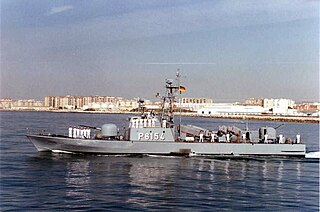 W
WThe Type 148 Tiger-class fast attack craft is a modification of the French La Combattante IIa design for the German Navy.
 W
WThe Tondar class consists of ten fast attack crafts operated by Navy of the Islamic Revolutionary Guard Corps of Iran.
 W
WThe Tuima class missile boat was a class of fast attack craft in use by the Finnish Navy.
 W
WChina first received a single unit of Soviet Osa-class missile boat in January 1965, and four more in 1966 through 1967 and the last two in 1968. The Hudong Shipyard built the Chinese version as Type 021-class missile boat at a rate of ten boats per year with several different versions. The majority of this class is being transferred to reserve status. Several dozen remain active and these active units are being rearmed with C-101 supersonic anti-ship missiles. Bangladesh Navy Type 021 missile boats rearmed with C-704 high subsonic anti-ship missiles. These boats are effectively used in swarm missile attacks.
 W
WThe Type 22 missile boat is a ship class in the Chinese People's Liberation Army Navy. The first boat was launched in April 2004 by the Hudong-Zhonghua Shipyard at Shanghai. The boats incorporate stealth features and are based on Australian-designed wave-piercing catamaran hulls that are more stable than other fast missile craft in high sea conditions. 82 of these missile boats are currently in service with three flotillas having been produced over a span of seven years.
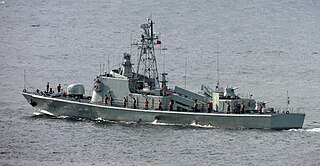 W
WThe Type 037 corvette is a series 400–500 ton corvette type classes in service with the People's Liberation Army Navy. Unlike western navies, the People's Liberation Army Navy does not have dedicated patrol boats in its inventory. Instead, a large variety of corvette type classes, in the form of missile boats and submarine chasers fulfill the tasks of patrolling China's territorial waters. The Egyptian Navy operates eight vessels.
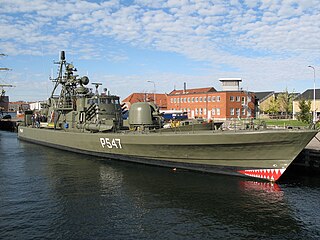 W
WThe Willemoes-class missile boat was a Royal Danish Navy class of fast missile boats serving from late 1970s until 2000. Designed by Orlogsværftet, in conjunction with the German yard Lürssen, the Willemoes class could achieve a maximum speed in excess of 40 knots. Their weapons consisted of one 76 mm (3 in) OTO Melara gun and combination of RGM-84 Harpoon missiles and torpedo tubes. When the full assortment of eight Harpoons was carried, two 553 mm (22 in) torpedo tubes were carried as well. With Harpoons removed, up to four torpedo tubes could be mounted.
 W
WThe Yıldız class is series of two fast attack craft/missile boats of the Turkish Navy. They class was designed by Lürssen Werft of Germany and share the same hull layout as the preceding Doğan class. Both ships of the class were built in Turkey and entered service in 1996. They remain in service.